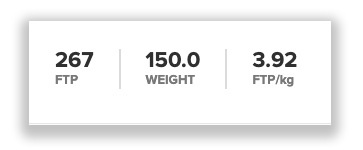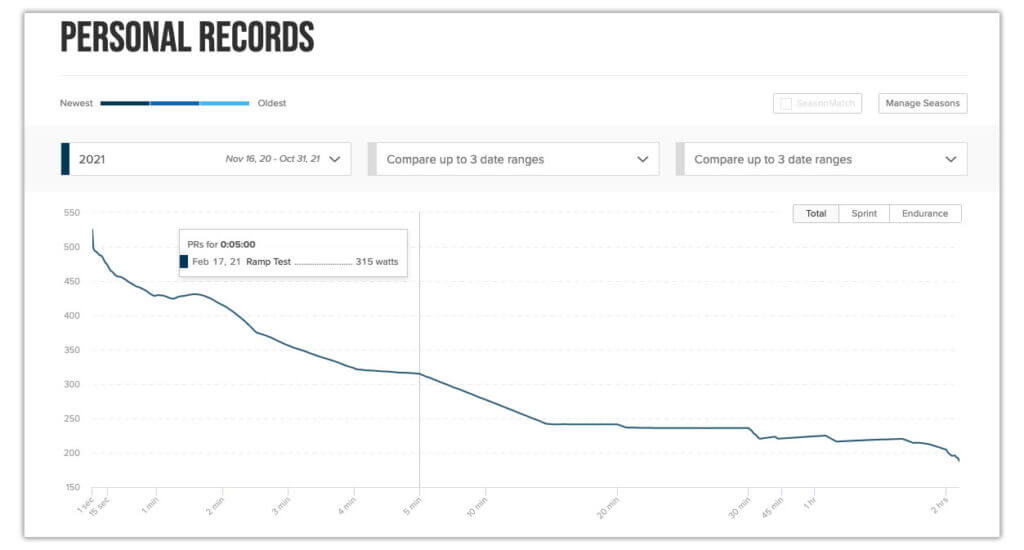Power-to-Weight Ratio for Cyclists: When Watts/kg Matters, and How to Improve It
Power-to-weight ratio reflects a cyclist’s ability to generate power, relative to their body weight. When used correctly, this metric can offer useful insights into training and help to show improvement over time. When used improperly, it can serve as an excuse for athletes to unhealthily obsess over weight. Let’s take a closer look at what power-to-weight ratio is (and isn’t), and how it can be viewed in the proper context to help you get faster.
Want to calculate your Watts/kg? Use our calculator.
Key Takeaways
- Power-to-weight ratio is a useful measurement of how efficiently your body utilizes its mass to produce power.
- Overall power is more important than weight in most cycling situations.
- Some athletes use power-to-weight as a reason to fixate on weight, but this is often counterproductive and unhealthy.
- Almost every athlete can improve their power-to-weight ratio with structured training and a sensible diet.
What is Power-to-Weight Ratio (Watts per kilogram)?
Power-to-weight ratio is a measurement of your power on the bike, in comparison to your body weight. It is expressed as watts of cycling power produced per kilogram of body weight, abbreviated as W/kg.
Larger riders tend to be more powerful than smaller cyclists in absolute terms, but lighter riders require less energy to overcome inertia and propel themselves forward (especially uphill). Power-to-weight ratio thus offers a fairer way to compare different riders’ abilities than by looking at power alone. More importantly, it also allows individual athletes to better understand the nuance of their own abilities, as changes in fitness often occur in tandem with changes in body weight.
What are the Watts in Watts per kilogram?
Watts are the standard measurement of power generated by a rider while riding a bike. While metrics such as heart rate and speed are subject to outside influence, power is objective and comparable in any condition. Technically speaking, a watt is a measurement of energy transfer and is measured in real-time while cycling with a power meter. Most commonly, the watts in W/kg refers to your sustainable power (FTP).
FTP Testing
Knowing your power-to-weight ratio requires knowing your FTP, or functional threshold power. FTP is easily determined through some simple testing. Common FTP tests include 20-minute and 8-minute tests, but our favorite is the Ramp Test. Once you know your FTP, all you need is your current weight to find your power-to-weight ratio.
What is my Power-to-Weight Ratio?
To calculate your power-to-weight ratio, simply divide your FTP by your weight in kilograms. TrainerRoad displays your power-to-weight ratio using this formula at the top right of the career page. Or use our calculator.

Using your Power Curve
Power-to-weight ratio can also be useful to consider at other time durations, from short sprints to ultra-endurance rides. Finding your power-to-weight ratio for these time increments is the same as for FTP: divide your maximal power over your chosen time duration by your body weight in kg. You can then track changes over time as your weight and fitness varies.
To find your maximal power for other durations, use the Personal Records chart. By hovering your mouse over any point on the curve, you can see your best effort for that time frame.

Sample Power-to-Weight Ratios
The table below shows a sample range of power-to-weight ratios:
| Weight | 130W | 160W | 190W | 210W | 240W | 270W | 300W | 330W | 360W |
|---|---|---|---|---|---|---|---|---|---|
| 100 lbs (45.4 kg) | 2.86 | 3.52 | 4.18 | 4.62 | 5.28 | 5.95 | 6.60 | 7.26 | 7.92 |
| 120 lbs (54.4 kg) | 2.39 | 2.94 | 3.49 | 3.86 | 4.41 | 4.96 | 5.51 | 6.06 | 6.61 |
| 140 lbs (63.5 kg) | 2.04 | 2.51 | 2.99 | 3.30 | 3.77 | 4.25 | 4.72 | 5.19 | 5.66 |
| 160 lbs (72.6 kg) | 1.79 | 2.20 | 2.61 | 2.89 | 3.30 | 3.71 | 4.13 | 4.54 | 4.95 |
| 180 lbs (81.6 kg) | 1.59 | 1.96 | 2.32 | 2.57 | 2.94 | 3.30 | 3.67 | 4.04 | 4.41 |
| 200 lbs (90.7 kg) | 1.43 | 1.76 | 2.09 | 2.31 | 2.64 | 2.97 | 3.30 | 3.63 | 3.96 |
| 220 lbs (99.8 kg) | 1.30 | 1.60 | 1.90 | 2.10 | 2.40 | 2.70 | 3.00 | 3.30 | 3.60 |
| 240 lbs (108.9 kg) | 1.19 | 1.46 | 1.74 | 1.92 | 2.20 | 2.47 | 2.75 | 3.03 | 3.30 |
| 260 lbs (117.9 kg) | 1.10 | 1.35 | 1.61 | 1.78 | 2.03 | 2.29 | 2.54 | 2.79 | 3.05 |
When is Power-to-Weight Ratio important?
As a direct factor in performance, power-to-weight ratio is usually less important than you might think. Only on long and steep climbs does power-to-weight become the most important variable, and this terrain is fairly rare in amateur racing. But bike racing at all levels is about conserving energy, and power-to-weight is still a factor. A small reduction in weight can make a big difference in cumulative effort over the course of a long event.
When is Power More Important Than Power-to-Weight?
On flat or rolling terrain, aerodynamics and raw power play a much bigger role than watts per kilogram. In fact, at racing speeds, almost 90% of a cyclist’s power is expended overcoming wind resistance. And while bigger riders do tend to have a larger profile in the wind, their increased resistance when compared to smaller cyclists is often outweighed by their superior ability to generate power. This is why larger and more powerful riders tend to win flat and windy races, while smaller climbers shelter in the pack. Simply put, in most situations, power is more important than power-to-weight.
Power-to-Weight as a Performance Metric
Apart from its direct implication on performance, power-to-weight is useful to track as a signifier of efficiency. A higher power-to-weight ratio indicates a greater proportion of lean muscle mass and a stronger aerobic engine. So, while your W/kg does directly influence your climbing ability, it’s also a good indication of general fitness and body composition as it relates to cycling.
Adaptive Training
Get the right workout, every time with training that adapts to you.
Check Out TrainerRoadTraining to Improve W/kg
There are two ways to improve your power-to-weight ratio: by increasing power, and by decreasing weight. Sometimes the two go hand-in-hand, but not always.
Increasing Power
Since aerodynamics and raw power are generally more important than weight, increasing your ability to generate power can have a huge impact. The simplest way to do this is by following a structured training plan. TrainerRoad makes that easy, and with Plan Builder your training will specifically target the fitness you need to reach your goals.
As you get fitter your sustainable power will increase, and your power-to-weight ratio will improve. But getting stronger is only half the battle, and many athletes also address the other half of the W/kg equation: weight.
Decreasing Weight
Losing weight while maintaining or improving the ability to produce power is the holy grail of training. While most athletes naturally lose some weight over the course of a training plan, many of us also try other strategies for additional weight loss. If you decide to go this route, avoid dramatically cutting calories and instead prioritize consistent training and sensible eating to fuel your workouts and recovery.
A fixation on weight and skinniness is dangerously common in cycling. High power-to-weight ratios signify efficiency and optimal body composition, and this does not necessarily mean lighter or skinnier. Excessive weight loss negatively affects power-to-weight ratio by reducing muscle mass, and many riders are proportionally more powerful at a slightly higher weight.
Consider weight loss in the context of making yourself healthier, rather than chasing it as an end in and of itself. Your current body composition may make sensible weight loss a beneficial target for watt/kg improvement, but if you are already very lean it may bring diminishing returns and should take a back seat to improvements in power.
What is a Good W/KG?
Power-to-weight ratios vary across a wide spectrum. Generally, untrained riders have an FTP below 2.0 W/kg for men and 1.5 W/kg for women, while professional racers may be capable of sustaining more than 6.0 W/kg for men and 5.5 for women. The majority of TrainerRoad athletes have power-to-weight ratios between 2.25 W/kg and 3.5 W/kg, but many of our athletes sit well above or below this range.
Wherever your current W/kg, take heart. Almost everyone can significantly improve their power-to-weight ratio with structured training. How much improvement to expect depends on a number of factors, including available training time, experience level, age, and genetics, among others. Your goals should play a role in determining your expectations- how fit do you need to be to achieve success in your target event? Winning the local crit won’t require a pro-level power-to-weight ratio, but might be just the goal you need to push yourself to the next level.
